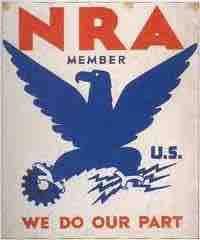NATIONAL INDUSTRIAL RECOVERY ACT
Franklin Delano Roosevelt signed the National Industrial Recovery Act (NIRA) only three months after he took over the office (June 1933). It was one of the most prominent and controversial New Deal laws focused on boosting the industry. It aimed "to encourage national industrial recovery, to foster fair competition, and to provide for the construction of certain useful public works." Title I of the Act was devoted to industrial recovery. First, trade and industrial associations were permitted to seek presidential approval of "codes of fair competition." The codes would contain production, labor, and trade guidelines for each industry in order to limit competition and encourage cooperation. They could not promote monopolies or create unfair competition for small businesses and were exempt from federal antitrust laws. Second, workers were guaranteed the right to unionize and bargain collectively. Third, Title I provided standards of maximum work hours, minimum wages, and labor conditions that the codes would cover. Title II established the Public Works Administration (PWA), an agency that would create jobs through public work projects. It also provided funding for a series of transportation projects, local initiatives that would battle unemployment through public work projects, and necessary acquisitions of property that would make such projects possible.
NIRA gave the administration the power to develop voluntary agreements with industries regarding work hours, pay rates, and price fixing. The codes of fair competition were to be developed through public hearings. In his June 16, 1933 "Statement on the National Industrial Recovery Act," President Roosevelt noted, "On this idea, the first part of the NIRA proposes to our industry a great spontaneous cooperation to put millions of men back in their regular jobs this summer. " He further stated, "But if all employers in each trade now band themselves faithfully in these modern guilds, without exception, and agree to act together and at once, none will be hurt and millions of workers-- so long deprived of the right to earn their bread in the sweat of their labor-- can raise their heads again. The challenge of this law is whether we can sink selfish interest and present a solid front against a common peril. "
Roosevelt signs the National Labor Relations Act
Francis Perkins looks on as Franklin Roosevelt signs the National Labor Relations Act.
NATIONAL RECOVERY ADMINISTRATION
At the center of NIRA was the National Recovery Administration (NRA), headed by Hugh S. Johnson, whom Roosevelt made responsible for industrial recovery. The agency's main purpose was to plan and introduce regulations that would boost industrial recovery and employment opportunities. NRA envisioned government experts, business representatives, and workers to write the codes of fair practices that would reduce competition and establish labor and production rules in each industry. Minimum wages, maximum working hours, prices, and production quotas were all to be covered under the codes. These set rules, agreed upon by a coalition of economic actors that would often remain in conflict with each other, were intended to shape the economic recovery by preventing labor disputes, regulating levels of production, preventing further deflation (regulate prices), and establishing fair labor conditions.
Johnson called on every business establishment in the nation to accept a stopgap "blanket code": a minimum wage of between 20 and 45 cents per hour, a maximum workweek of 35–45 hours, and the abolition of child labor. Together with Roosevelt, he contended that the "blanket code" would raise consumer purchasing power and increase employment.
Following the provisions of NIRA, NRA engaged in drafting the codes. It approved 557 basic and 189 supplemental industry codes in two years and became notorious for generating large numbers of regulations. Between 4,000 and 5,000 business practices were prohibited, some 3,000 administrative orders running to over 10,000 pages promulgated, and thousands of opinions and guides from national, regional, and local code boards interpreted and enforced the Act.
CRITICISM
NIRA and consequently NRA attracted widespread criticism from business, politics, labor, and intellectuals. While some complained that the federal government was too involved in the regulation of the industry, others pointed out that it was industries that mostly wrote the codes and thus preserved a fair amount of control. Furthermore, NIRA's labor protection provisions were not respected by employers. Higher prices, although welcomed in light of the severe deflation, did not boost economy as wages remained low and the consumers' purchasing power did not alter. In 1935, the U.S. Supreme Court unanimously declared that NIRA was unconstitutional, ruling that it delegated legislative powers to the executive and regulated commerce that was not interstate in character. NRA's role was redefined by an executive order. The agency now promoted industrial cooperation and produced economic studies.
Many of NIRA labor provisions reappeared in the National Labor Relations Act (Wagner Act), passed later the same year. Te NLRA enabled private sector workers to organize into trade unions, engage in collective bargaining to negotiate the terms and conditions of their employment without being marginalized or coerced, and take collective action if necessary. In the long-term, the Act allowed a surge in the growth and power of unions, which became a core part of the New Deal Coalition.

An NRA poster featuring the agency's Blue Eagle symbol.
As part of a publicity campaign by NRA, participating businesses could display the NRA's Blue Eagle emblem. Participation was voluntary, but businesses without the Eagle were often boycotted.